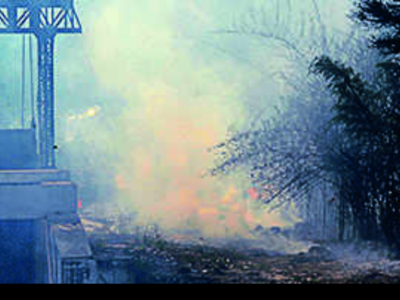Hyderabad : 03/07/2021
Bad air quality fans Covid-19 spread, finds study in 300 districts including Hyderabad

HYDERABAD: A research study involving 300 districts across India, including Hyderabad, Vijayawada and
Visakhapatnam, reveals that air quality plays a crucial role in the outbreak of the Covid-19 pandemic. The study suggests that improving air quality with proper strict regulations whenever Covid-19 cases peak could help reduce infection and mortality rates.
The study, spanning over one year (April 2020 to March 2021) covering summer, monsoon and winter seasons, reveals that among the air pollutants, atmospheric ozone was better correlated with infection counts followed by aerosol thickness, carbon monoxide, nitrogen dioxide, black carbon and sulphur dioxide.
The researchers observed that among the weather parameters, air temperature, incoming short-wave radiation, wind speed are positively and significantly associated with outbreak pattern, and precipitation (rainfall) and humidity are negatively correlated with confirmed cases.
Only cloud cover has no significant relation. Coastal districts and areas located in the plain and low-lying areas experienced a bitter situation during this pandemic", according to the study published in online preprint portal MedRxiv on July1.
The spatial distribution of cases also depicted that the coastal districts were more anguished by misfortune than the districts located in the interior part of the country whereas the districts from the Himalayan Mountains and its foothills had lesser strife during this pandemic. The study found that among other areas,
Andhra Pradeshhad inhaled quite bad air. This also explains why AP, being primarily a coastal state, has reported more Covid-19 infections than
Telangana, which is far away from the coast.
The research team comprising Amitesh Gupta and Laboni Saha from Savitribai Phule Pune University, and RBased Services Private Limited, New Delhi, investigated the role of regional meteorology and air quality parameters in the outbreak pattern of Covid-19 pandemic. They used the remote sensing-based dataset of 12 environmental variables to correlate infective case counts at the district level.
Districts located near and along the coast reported maximum cases during May to July 2020 which is the onset duration of monsoon over Indian subcontinent, thus experiencing higher wind from the sea-side towards the land. The rapid weather variability might result in an increase in respiratory infections in warming climatic conditions. Higher ambient temperature could restrain the adaptive immune response to a virus infection, the study said.
The study showed that 35.03% districts had registered cases within the range of 10,000 to 1,00,000 while only 3.05% districts reported more than one lakh cases during the period. Most of the districts registered counts of infective cases within the range of 2,500-5,000 following the range of 10,000-25,000. It has also found 21 states registered more than one lakh infected cases.
“Intriguingly, the temporal trends of pollutants showed comparatively higher concentration during winter and post-monsoon seasons, while the infections were relatively lesser in both those seasons. Therefore, it suggests that the shoddy air quality could not be discretely blameworthy for coronavirus dissemination in India, rather bad air,” the researchers said.
No comments:
Post a Comment